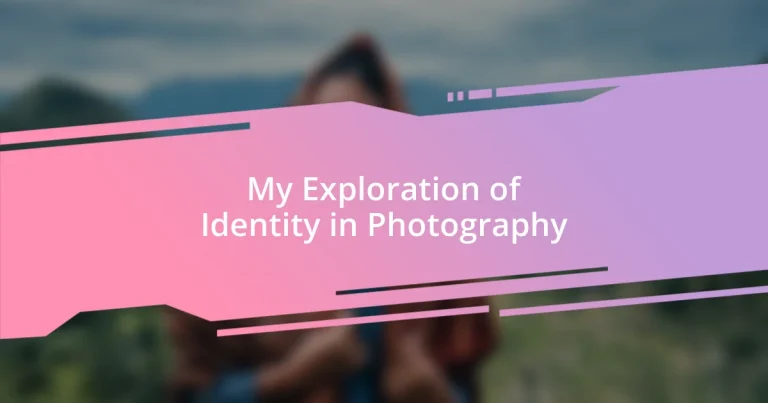Key takeaways:
- Identity in photography transcends individual perception and incorporates cultural experiences, revealing deeper narratives in both subject and artist.
- Self-portraiture is a tool for introspection, helping individuals confront their emotions and uncover layers of identity tied to personal experiences.
- Notable photographers like Zanele Muholi, Carrie Mae Weems, and Elinor Carucci utilize their work to explore complex themes of identity, culture, and the shared human experience.
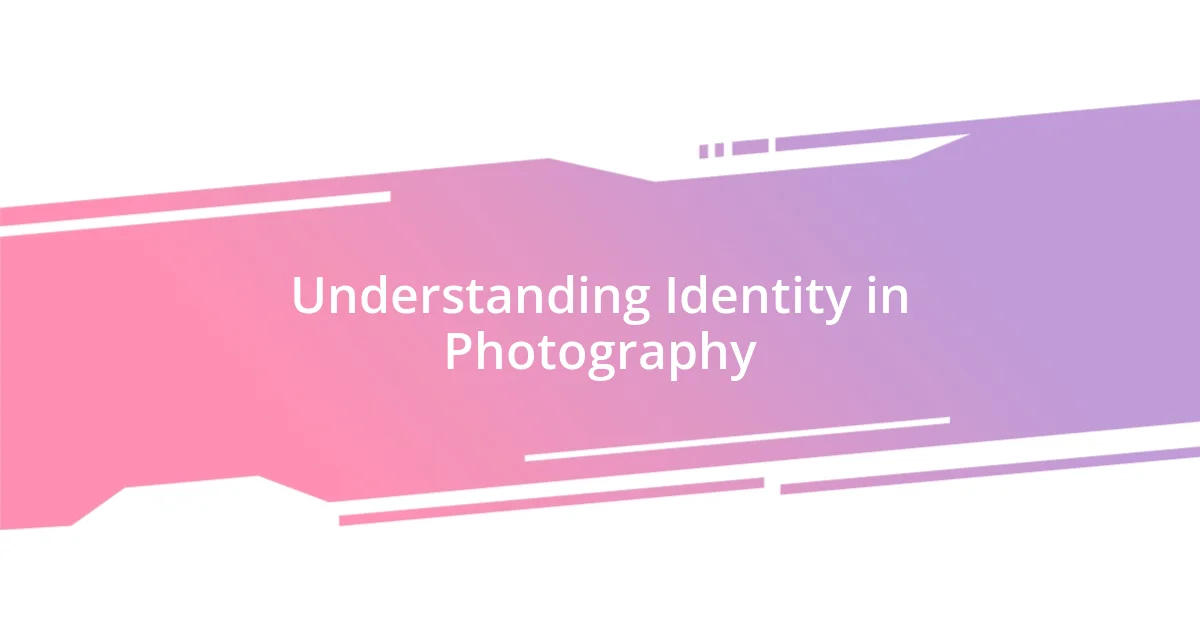
Understanding Identity in Photography
Identity in photography is fascinating because it captures not just who we are, but how we want to be perceived. For instance, when I take a portrait, I often ask my subject, “What story do you want to tell?” This question can lead to surprising revelations and choices in pose, expression, and even wardrobe, turning a simple photo shoot into an exploration of self.
The concept of identity extends beyond the individual to the artist. I remember an especially transformative moment while editing a series of images from a cultural festival. As I worked, I realized the colors and expressions I highlighted were reflections of my own mixed heritage. It made me wonder: how much of our identity do we infuse into our work without even realizing it? This realization deepened my understanding that every photograph, whether conscious or not, can narrate a broader cultural experience.
In essence, our choices in photography can reveal layers of our identities. Think about this: when you scroll through your own collection, what themes emerge? My own exploration led me to notice a recurring focus on community and connection. Each image, whether joyful or somber, seems to serve as a fragment of my ongoing narrative about who I am and where I belong.
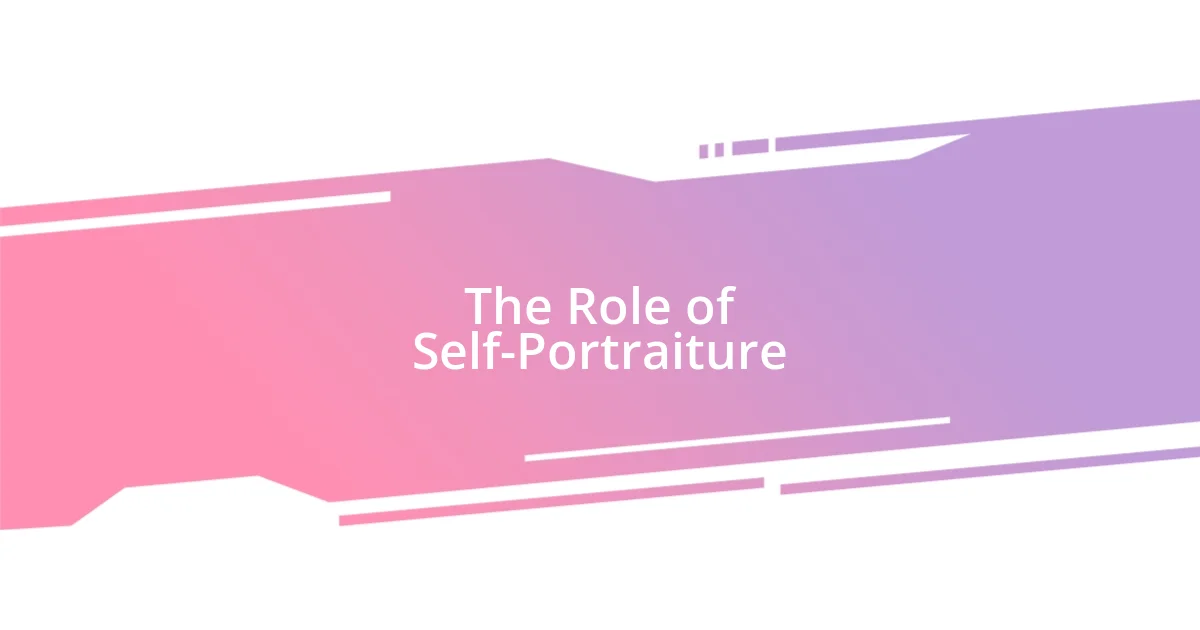
The Role of Self-Portraiture
Self-portraiture serves as a powerful tool for introspection and self-exploration. I recall the first time I stepped in front of the camera, feeling a blend of excitement and vulnerability. Capturing my likeness forced me to confront not only my physical appearance but also the emotions and truths I often kept hidden. Each click felt like peeling back layers of my identity, revealing deeper aspects of myself that I had yet to fully understand.
What I find particularly intriguing about self-portraiture is its ability to reflect personal narratives. One evening, I set up my camera to capture a mood rather than a moment. I draped myself in fabrics that felt significant to me and chose lighting that evoked a sense of yearning. The resulting image wasn’t just a photograph; it was a story of longing, a visual representation of my hopes and dreams. This experience showed me that a well-composed self-portrait can serve not just as a reflection of oneself but a mirror that reveals layers of our aspirations and fears.
The act of self-portraiture can cultivate a deeper connection to one’s identity over time. I remember revisiting some of my earlier self-portraits—to my surprise, each image triggered specific memories and feelings. For instance, one photo taken during a challenging phase of my life resonated with a sense of resilience. It reminded me that while I see the change in my appearance, the essence of my experiences still shines through. This journey of capturing myself has made me appreciate the complex interplay of identity and narrative within photography.
| Aspect | Self-Portraiture |
|---|---|
| Emotional Reflection | Reveals inner emotions and vulnerabilities |
| Personal Narrative | Tells unique stories of aspiration and fear |
| Connection to Identity | Builds awareness of growth and change |
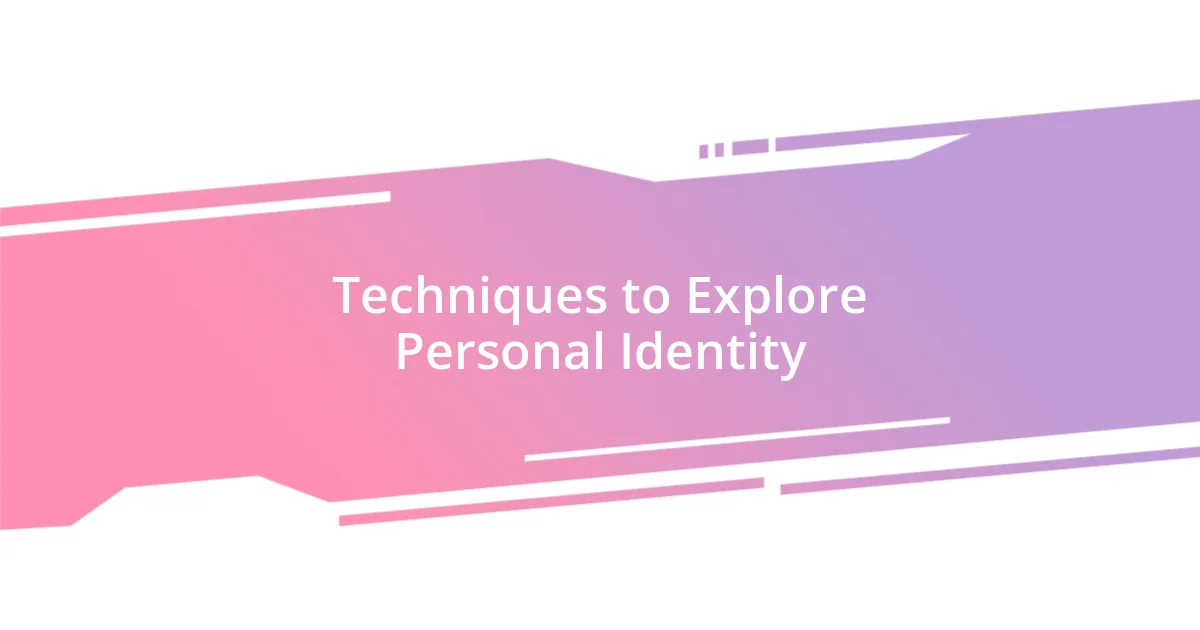
Techniques to Explore Personal Identity
Exploring personal identity through photography can happen in various ways, and I’ve found experimenting with different techniques can yield profound insights. One method I enjoy is the use of symbolic props. For instance, during a project around my childhood memories, I held objects like my grandmother’s necklace and an old book, which served as tangible links to my past. Each image not only represented me physically but also connected to formative experiences that shaped my identity.
Consider trying these techniques to deepen your exploration of personal identity:
- Use Symbolic Props: Incorporate items that hold personal significance to you.
- Experiment with Lighting: The use of shadows or bright lighting can convey different emotions.
- Explore Locations: Capture images in places that resonate with your life experiences.
- Incorporate Text: Pair your images with handwritten notes or quotes that encapsulate your feelings.
- Engage with Movement: Capture yourself in motion to express dynamism or change in your journey.
Engaging with these techniques may reveal layers of who you are, perhaps even uncovering aspects you didn’t realize were there. When I started using my travel experiences as a backdrop for self-portraits, it opened up a dialogue about the ways those journeys influenced my identity. Standing in front of a breathtaking landscape as my setting made me realize how connected I felt to the places that have shaped my view of the world. The simple act of connecting my physical self with meaningful locations transformed my photography, and I believe it could do the same for anyone willing to dive in.
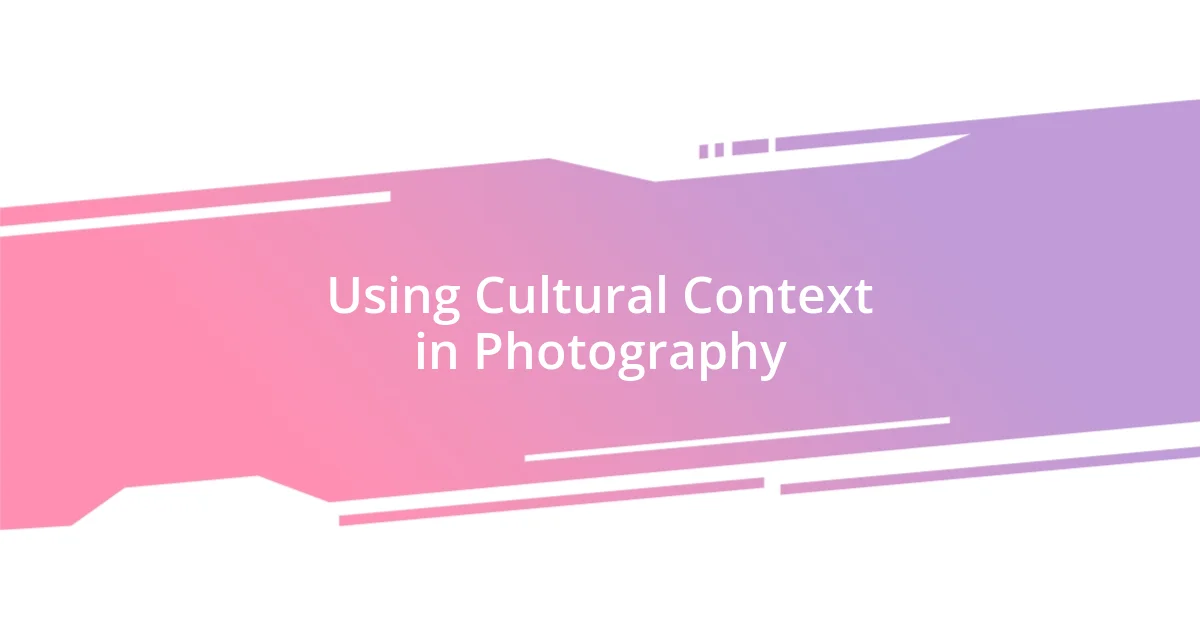
Using Cultural Context in Photography
Using cultural context in photography can profoundly influence how we express our identities. I remember the first time I photographed a traditional dance in my community. The vibrant colors, intricate costumes, and joyful expressions of the dancers took me back to my childhood and ignited a sense of pride in my heritage. It made me wonder—how much of my identity is shaped by these rich cultural experiences? Capturing that moment wasn’t just about the technique; it was about interweaving my personal story with the cultural tapestry around me.
In another instance, while exploring urban spaces, I found myself drawn to street art that told powerful stories about community experiences. As I framed my shots, I felt the weight of history and resilience within those murals. This connection to the creative expressions of others reminded me that our identities aren’t created in isolation. Instead, they are reflections of our surroundings, shaped by the cultural contexts we navigate every day. How often do we consider the voices that whisper through the buildings and walls we pass by?
Moreover, I discovered that integrating cultural artifacts into my photographs could add a layer of depth and meaning. One day, I photographed a family heirloom alongside my own portrait, stitching together the past and the present. This simple act created a bridge between generations, revealing a multifaceted identity that encompasses both personal and cultural narratives. I often reflect on this interplay—how does our cultural context inform our self-perception? In my experience, it’s an essential facet of understanding who we are as individuals and as part of a larger community.
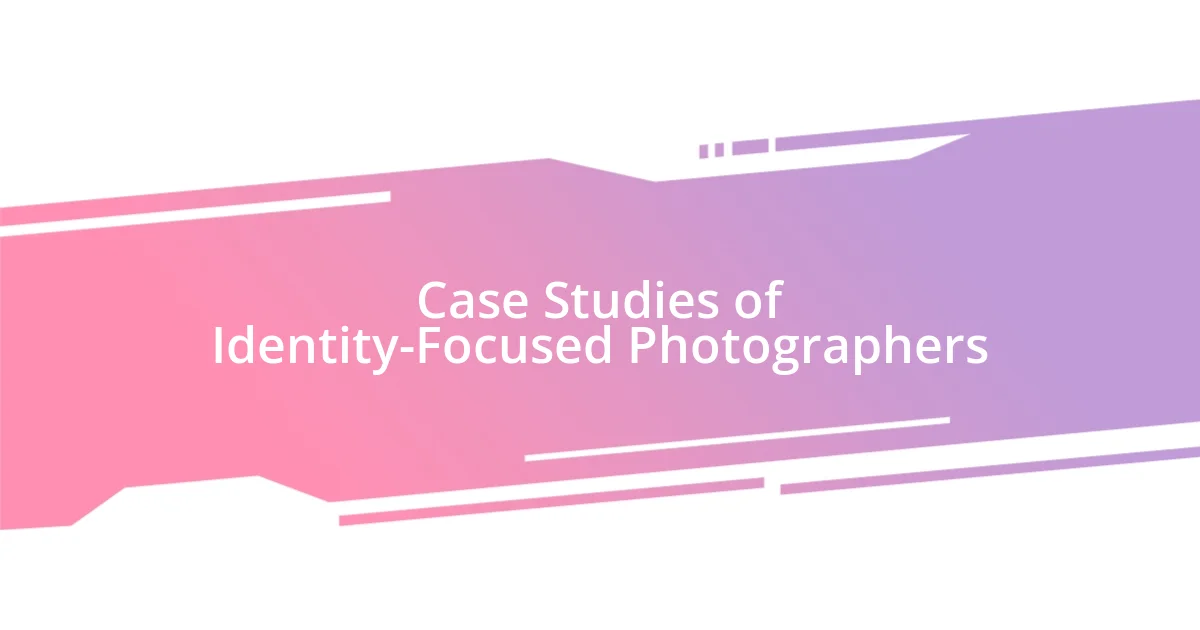
Case Studies of Identity-Focused Photographers
One photographer who truly embodies the exploration of identity is Zanele Muholi. Their work focuses on documenting the lives and experiences of South Africa’s LGBTQ+ community, creating powerful images that celebrate both individuality and collective identity. I remember feeling a rush of admiration when I first saw their portraits; each one told a story of resilience and pride that resonated deeply with my own journey of self-discovery. How do we honor the narratives of those who bravely share their truth? Muholi’s lens provokes us to reflect on our own identities in relation to the broader cultural tapestry.
In another compelling example, artist Carrie Mae Weems uses her photography to investigate the complexities of race and gender. Viewing her series “Kitchen Table Series” was a transformative moment for me. The intimate setting and candid compositions made me examine my own domestic spaces and the narratives they harbor. How often do we consider the stories hidden within our everyday surroundings? Weems invites us to not only look but to feel, making the viewer acutely aware of the interconnectedness of personal and shared experiences.
Finally, there’s the work of Elinor Carucci, whose intimate self-portraits explore motherhood and femininity. Her images convey a raw honesty that struck a chord with me, as I reflected on my own evolving identity through various life stages. The vulnerability present in her photos poses an essential question: How do our roles shape who we become? Carucci’s journey encourages viewers to embrace their multifaceted identities and discover beauty in what often feels like chaos. Each case study presents a different angle on identity, highlighting the power of photography to articulate who we are.












